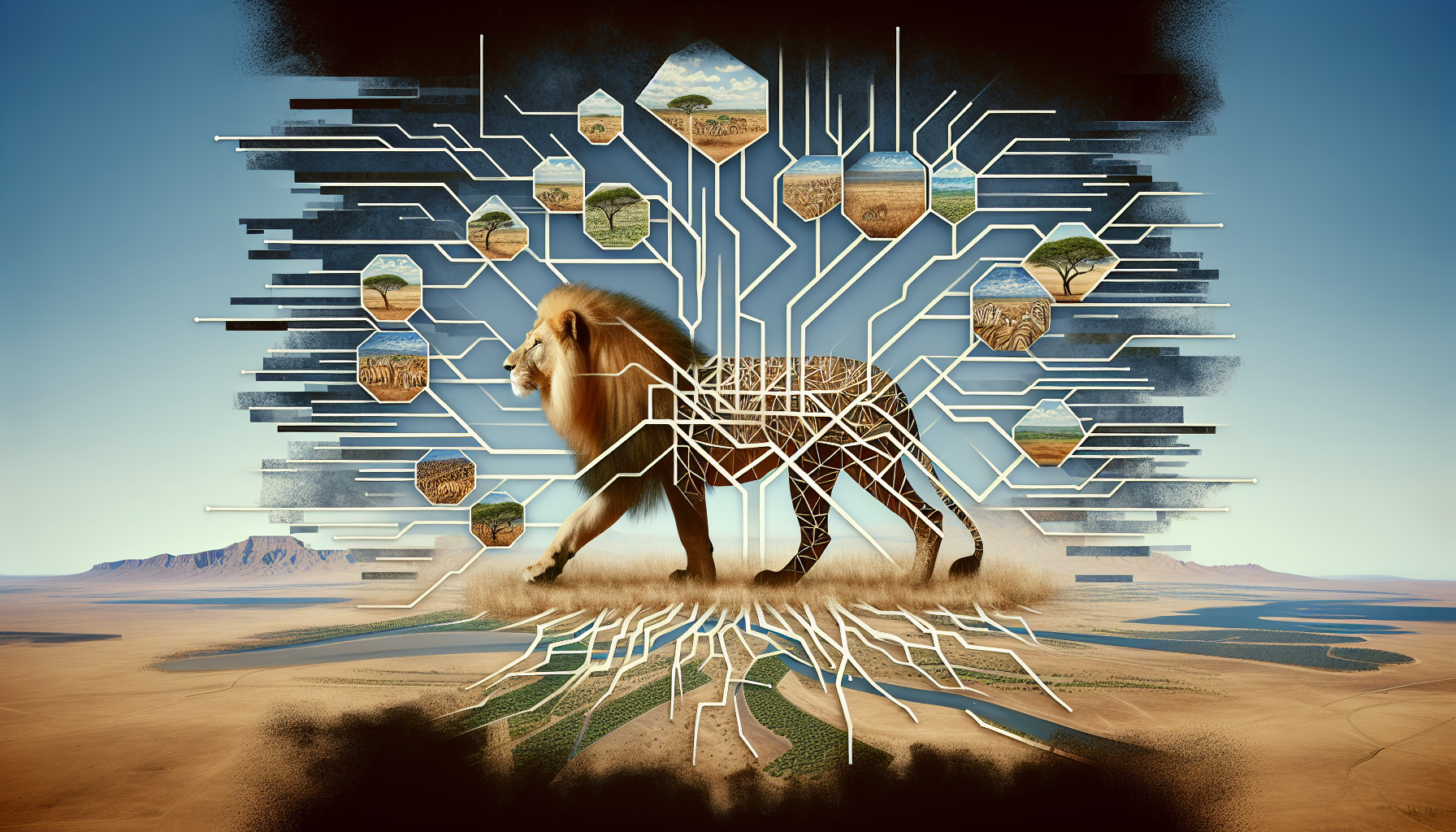Imagine a world where lions roam freely across vast landscapes, where their populations are interconnected, and where they can thrive without being confined to fragmented areas. This is the vision behind the concept of building corridors for lions to connect disparate populations. These corridors act as pathways, allowing lions to safely move between habitats, ensuring gene flow and preventing genetic isolation. In this article, we will explore the importance of building corridors for lions and the positive impact it has on their conservation.
Benefits of Connecting Disparate Lion Populations
Increased genetic diversity
Connecting disparate lion populations offers numerous benefits, the first being increased genetic diversity. When populations are isolated, they often experience reduced genetic variation, which can lead to inbreeding and decrease their overall fitness. By establishing corridors between these populations, lions have the opportunity to breed with individuals from different genetic backgrounds, increasing their genetic diversity and helping to maintain healthy populations.
Improved survival rates
Another benefit of connecting lion populations is improved survival rates. Disparate populations often face different challenges and threats, such as disease outbreaks or natural disasters. By establishing corridors, these populations can share resources and genetic traits that enable them to better adapt to changing environments and overcome these challenges. This increased gene flow reduces the risk of local extinctions and helps to ensure the long-term survival of lion populations.
Enhanced resilience to habitat loss
Habitat loss is a significant threat to lions, as it fragments their habitats and restricts their ability to move and find suitable resources. By connecting disparate lion populations, corridors provide a means for lions to navigate through fragmented landscapes, increasing their access to larger and more diverse habitats. This enhanced resilience to habitat loss allows lions to disperse, find new territories, and continue to thrive even in the face of habitat degradation and fragmentation.
Factors Affecting Connectivity Between Lion Populations
Land fragmentation
Land fragmentation is a key factor that affects the connectivity between lion populations. As human activities expand, habitats become fragmented, creating barriers and preventing lions from freely moving between areas. Factors such as roads, urban development, agriculture, and fences can divide lion populations, isolating them and limiting their ability to disperse, find mates, and search for suitable habitats.
Human-wildlife conflict
Another significant factor that affects connectivity between lion populations is human-wildlife conflict. As lions come into closer contact with human settlements and livestock, conflicts arise, leading to retaliatory killings and habitat destruction. These conflicts often occur near the boundaries of protected areas, further limiting lion movement and connectivity. Addressing human-wildlife conflict and promoting coexistence is crucial for establishing effective lion corridors.
Physical barriers
Various physical barriers hinder lion movement and connectivity. For instance, rivers, mountains, and large expanses of unsuitable habitats can act as natural barriers, isolating lion populations. Additionally, man-made structures, such as highways, railway lines, and fences, can create significant obstacles for lions, impeding their ability to move freely and restricting their access to essential resources. Removing or mitigating these physical barriers is essential for developing effective corridors for lion populations.

Identifying Priority Areas for Corridor Development
Mapping lion populations
To identify priority areas for corridor development, it is important to map lion populations accurately. Gathering data on lion distribution and population densities helps identify areas with the highest concentrations of lions and areas where populations are isolated. This information is crucial for determining where corridors are most needed to connect these isolated populations and support their long-term survival.
Assessing habitat suitability
Assessing habitat suitability is another important step in identifying priority areas for corridor development. This involves evaluating factors such as vegetation type, availability of prey, and the presence of natural resources that lions require to thrive. By identifying areas with suitable and contiguous habitats, conservationists can prioritize these locations for corridor development, ensuring lions can access the resources they need to survive and reproduce.
Evaluating potential connectivity routes
Evaluating potential connectivity routes is a crucial aspect of corridor development. This involves studying the landscape, identifying areas with minimal human disturbances, and assessing the feasibility of creating connections between fragmented lion populations. Factors such as topography, land use patterns, and the presence of physical barriers must be carefully considered to determine the most effective and efficient routes for establishing lion corridors.
Techniques to Establish Lion Corridors
Habitat restoration and conservation
Habitat restoration and conservation play a vital role in establishing lion corridors. It involves enhancing existing habitats and creating new ones, ensuring they are suitable for lion movement and population expansion. Techniques such as reforestation, controlling invasive species, and implementing sustainable land management practices can help restore and protect crucial habitats, making them more conducive to lion movement and dispersal.
Green infrastructure development
Green infrastructure development is another effective technique for establishing lion corridors. It involves strategically planning and creating networks of natural and semi-natural habitats that connect fragmented areas. This can include preserving and enhancing riparian zones, creating wildlife-friendly road crossings, and incorporating wildlife corridors into infrastructure development plans. Green infrastructure ensures the connectivity of lion populations while also benefiting other species and enhancing ecosystem services.
Translocation of lions
Translocation of lions is an intervention used to establish or strengthen lion corridors. This technique involves capturing and relocating lions from one population to another, effectively connecting previously isolated populations. Translocation must be carefully planned and implemented to ensure the genetic integrity and social dynamics of both the source and destination populations are maintained. It can help establish new breeding groups, increase genetic diversity, and improve gene flow within lion populations.

Case Studies: Successful Lion Corridors
Amboseli-Tsavo corridor in Kenya
The Amboseli-Tsavo corridor in Kenya serves as an excellent example of a successful lion corridor. This corridor connects the Amboseli and Tsavo East National Parks, two significant lion populations in the country. By establishing this corridor, lions from Amboseli can disperse and migrate to Tsavo, increasing gene flow and ensuring the long-term viability of both populations. This project involved collaboration between conservation organizations, local communities, and government agencies, highlighting the importance of stakeholder engagement in corridor development.
Niassa-Selous corridor in Tanzania and Mozambique
The Niassa-Selous corridor, spanning across Tanzania and Mozambique, is another noteworthy case study in successful lion corridor conservation. This corridor connects the Niassa Reserve in Mozambique with the Selous Game Reserve in Tanzania, facilitating the movement and gene flow between these two important lion populations. By establishing this corridor, lions have a larger range to disperse and explore, reducing the risk of inbreeding and increasing their chances of survival. The project involved close collaboration between government agencies, conservation organizations, and local communities, showcasing the importance of cross-border cooperation in corridor conservation.
Kavango-Zambezi transfrontier conservation area in southern Africa
The Kavango-Zambezi (KAZA) transfrontier conservation area in southern Africa is the largest conservation area in the world and serves as a prime example of a successful initiative to establish lion corridors. Spanning across five countries (Angola, Botswana, Namibia, Zambia, and Zimbabwe), KAZA aims to facilitate movement and connectivity of various species, including lions. The establishment of community conservancies, wildlife corridors, and transfrontier management initiatives has helped ensure the continued survival and connectivity of lion populations across this vast landscape.
Challenges and Limitations of Corridor Building for Lions
Political and jurisdictional challenges
Building corridors for lions often involves navigating complex political and jurisdictional challenges. It requires collaboration and coordination among different landowners, government agencies, and stakeholders with varying interests and priorities. Conflicting land-use policies, bureaucratic processes, and differing conservation approaches can hinder the establishment of effective corridors. Overcoming these challenges requires strong leadership, effective communication, and the development of shared goals and strategies among all involved parties.
Resistance from local communities
Local communities are key stakeholders in corridor building for lions, as their support and involvement are crucial for successful implementation. However, resistance from local communities can arise due to concerns about livestock predation, potential impacts on livelihoods, or cultural beliefs. Addressing these concerns and ensuring that local communities benefit from corridor conservation efforts through initiatives such as community-based conservation programs and ecotourism can help alleviate resistance and garner support for corridor building.
Maintenance and long-term management
Once corridors are established, their maintenance and long-term management pose continuous challenges. Regular monitoring and maintenance of corridors are essential to prevent encroachment, habitat degradation, and human disturbances that can negatively impact lion movement. Securing funding for ongoing management, ensuring the involvement of local communities, and establishing effective governance structures are vital to the sustained success of lion corridors.
Benefits to Other Species and Ecosystems
Increased biodiversity
Connecting disparate lion populations through corridors not only benefits lions but also enhances biodiversity in general. By facilitating the movement of lions, corridors indirectly support the dispersal of other species, enabling gene flow and promoting population resilience. This increased biodiversity contributes to the overall health and functioning of ecosystems, improving their ability to withstand disturbances and adapt to changing conditions.
Ecological balance restoration
Lion corridors play a crucial role in restoring ecological balance in fragmented landscapes. As apex predators, lions influence the densities and behaviors of various herbivores, which, in turn, influence vegetation structure and composition. By connecting fragmented populations and allowing lions to disperse more freely, corridors enable these ecological processes to occur across larger landscapes, promoting a more balanced and sustainable ecosystem.
Conservation of endangered species
Corridor building for lions can also benefit the conservation of other endangered species. By creating connected landscapes, corridors facilitate the movement of species such as cheetahs, wild dogs, and elephants, all of which also face habitat fragmentation and loss. Corridor conservation efforts have the potential to safeguard critical habitats for these species, promote gene flow, and increase their chances of long-term survival.
Future Outlook for Lion Corridor Conservation
Strengthening international collaboration
The future outlook for lion corridor conservation depends on strengthened international collaboration. Lion populations span across multiple countries, making transboundary cooperation essential. By sharing knowledge, resources, and expertise, countries can work together to establish and manage effective corridors for lions. Initiatives such as the Lion Recovery Fund and the African Parks Network are already facilitating collaboration and providing support for corridor conservation efforts.
Integration with broader landscape conservation efforts
Integrating lion corridor conservation with broader landscape conservation efforts is crucial for long-term success. Ensuring connectivity at larger scales requires considering other elements, such as protected area expansion, wildlife-friendly land-use planning, and sustainable development practices. By incorporating corridor conservation into broader landscape planning, conservationists can maximize the benefits for multiple species and ecosystems.
Incorporating climate change considerations
As climate change continues to impact ecosystems worldwide, incorporating climate change considerations into lion corridor conservation is essential. Identifying and protecting climate-resilient habitats, implementing adaptive management strategies, and accounting for potential shifts in species distributions are vital for ensuring the long-term viability of corridors. By proactively addressing climate change impacts, corridor conservation efforts can be more effective and resilient in the face of a changing climate.
Conclusion
Building corridors for lions to connect disparate populations is a crucial conservation intervention that offers numerous benefits. Increased genetic diversity, improved survival rates, and enhanced resilience to habitat loss are among the key advantages. However, challenges such as land fragmentation, human-wildlife conflict, and physical barriers must be addressed. By using techniques such as habitat restoration, green infrastructure development, and translocation of lions, successful corridors can be established. Case studies like the Amboseli-Tsavo corridor in Kenya, the Niassa-Selous corridor in Tanzania and Mozambique, and the Kavango-Zambezi transfrontier conservation area in southern Africa demonstrate the effectiveness of corridor conservation. Corridor building not only benefits lions but also other species and ecosystems by increasing biodiversity, restoring ecological balance, and conserving endangered species. Strengthening international collaboration, integrating corridor conservation with broader landscape efforts, and incorporating climate change considerations are crucial for the future outlook of lion corridor conservation. Ultimately, building corridors for lions is a vital step towards ensuring their long-term survival and contributing to the conservation of biodiversity and ecological integrity.

